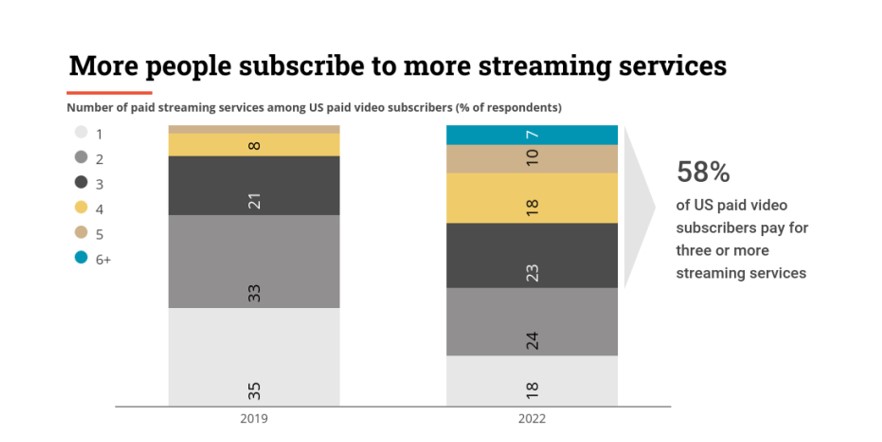The Future of Streaming is… TV?
12 September 2022
Share with a Friend
All fields required where indicated (*)Entertainment is a well-established area of our smart homes, but as the number of streaming services increases, the offer has grown too big, too expensive and too complicated to navigate.
Consumers are already becoming overwhelmed with the growing number of streaming options. In 2019, only 32% of US paid video subscribers paid for three or more services, today it is 58%1. Recent streaming price hikes in combination with rising inflation, however, will have consumers look again at their subscriptions.

Source: Nielsen, April 2022 sourced from eMarketer.
To find a solution to this issue, streaming companies are seeking inspiration in the revenue-generating methods that served the traditional TV business well for decades, such as advertising and bundling. The secret ingredient, however, might be found in recommendation. Who will be able to surprise us with unexpected content that we otherwise might not have found?
Competing for subscribers and advertisers
The growing competition of both global and local streaming players is making it increasingly hard to grow. In response, companies are becoming more conscious of costs. Netflix2, for instance, is cutting costs through layoffs and downscaling in production. Warner Bros. Discovery is also taking a more sensible approach to budgets and has axed several big productions as a result.
In addition, streaming services are considering alternative models. Netflix and Disney+ are now adding advertising to their services, following the example of HBO Max, Peacock, and Hulu who already offered ad-based tiers.
Naturally, advertisers are pleased, since they will finally be able to reach those previously inaccessible viewers. Competition in the overall streaming market, however, will only increase. In addition to YouTube, subscription services will have to face free ad-supported streaming television (FAST) such as Paramount’s Pluto, Comcast’s Xumo, Fox’s Tubi, and Amazon’s Freevee.
Subscription services, however, will have to walk a fine line to ensure that their ad-based tiers will not cannibalize too many higher-tier customers, while still reaching enough people to attract quality advertisers. To keep the experience as entertaining as possible, subscription services might be able to push advertisers to invent new ad forms that are as entertaining as the content the streaming services already serve, instead of reusing the existing 30-second ad.
Distributing bundles with more than content
In addition to cheaper ad-based tiers, a streaming bundle with an aggregated discount might also be a reason to keep subscribing. Disney already offers such a bundle of streaming channels with Disney+, Hulu, and ESPN. Netflix, meanwhile, has expanded into games, although less than 1% of their subscribers are playing them3.
A bundle, however, doesn’t have to be limited to content. The traditional distributors – cable companies such as Liberty Global, Comcast or Charter – have always sold bundles of video content as part of a broader service that included internet and telephony. Their existing presence in people’s homes gives them a key advantage to regain their position.
Amazon, Apple and Google offer even broader bundles. Amazon Prime consists of fast shipping, exclusive access to sales, and entertainment services that include music, games, photos and books in addition to video. Apple One includes TV, games, music and cloud storage.
Recommending surprising content
With advertising and bundling, the industry might be able to give people more value for their money. Nevertheless, it doesn’t address the most challenging issue: how to navigate the ever-increasing amount of content.
Today, most streaming services use their own complicated algorithms to point us to content we might like based on what we watched before combined with the personal details they learned from us.
What would happen, however, if they could also take into account how we feel, what we’ve done during the day or plan to do the next day, or what happens in our social network. For instance, which movies a good friend of mine recently watched and recommended.
Some services already offer elements of such recommendations. Spotify, for instance, allows us to follow people we know or celebrities we admire, while Tiktok has created a lean-back experience. So far, however, the secret code has not been cracked.
Good recommendation should be able to point us to content that drives discussions at the watercooler, but also to content that we otherwise we never would have come across. Ideally, it combines the lean-forward experience of actively searching for specific content with the lean-back posture of the channel-surfing couch potato.
The service that cracks the recommendation code might surprise us. It could be a streaming service or a distributor, a retailer or a device manufacturer or perhaps it will be an integral part of another smart home service that we haven’t even imagined yet.
Important Disclosure
Sign-up for our ETF newsletter